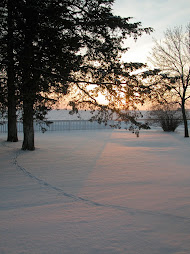You’ll notice the trees from the road. They stand, two pair, like giant pushpins fixing the corners of a picnic cloth. They spread shade over an otherwise sunny pasture; a plot where a few dozen Winnebago Indians once called home. This place was their reservation, briefly. I can’t say who planted the trees, or more importantly, why the four red-cedars form a perfect square when every other coniferous windbreak in this county stretches out as a straight line.
The eastern red-cedar is a sturdy, slow growing tree with fragrant wood and stringy bark. The wood is rot resistant, prized for pencils, fence posts, as lining for closets, and for longbows, flatbows and sinewed bows, which were favored by the native tribes. Because they grow so slow, the trees were sometimes called graveyard trees. Plant one for shade and it will shade your grave! Some eastern red-cedars in the United States are three hundred years old. I don’t know the age of our four cedars. There’s only one way to date a tree for certain so I’ll just keep guessing.
Sometimes, I imagine these four red-cedars to be related to the famed Cedars of Lebanon, my ancestral homeland, where a single stand of one thousand cedars is all that remain of the tree that is used seventy times in the bible as a metaphor for strength. Today, Lebanon’s cedars are fenced in, protected, guarded by handsome young soldiers who wear stern expressions under red felt berets. The trees are surrounded by metal mesh and men with automatic weapons. Don’t even think of carving your initials into these trees, folks.
King Solomon is the historical figure who clear-cut Mount Lebanon. Sadly, sustainable farming practices took a few millennia to really catch hold.
While both the eastern red-cedar and the giant cedar of Lebanon are imposing in their profile against an azure sky and both have limbs that bend and twist, defying gravity and reason, the trees are not at all related. The eastern red-cedar isn’t a cedar at all. It is a juniper. In most forms, it isn’t much more than a shrub.
But not here. Not at Four Cedars Farms. Here, under the craggily limbs of the red-cedars, the spirit of the ancient – the Winnebago or perhaps even the Phoenician – rides the prairie wind into a cool square patch of prairie shade. When that happens and you’re lucky enough to be stretched out in the hammock, it doesn’t really matter if the trees are shrubs, junipers, cedars, or metaphors. They are simply beautiful.
15 August 2007
Subscribe to:
Post Comments (Atom)






No comments:
Post a Comment